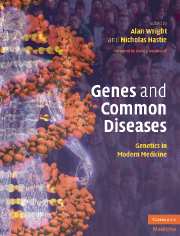Book contents
- Frontmatter
- Contents
- List of Contributors
- Foreword
- Section 1 Introductory Principles
- 1 Genes and their expression
- 2 Epigenetic modification of chromatin
- 3 Population genetics and disease
- 4 Mapping common disease genes
- 5 Population diversity, genomes and disease
- 6 Study design in mapping complex disease traits
- 7 Diseases of protein misfolding
- 8 Aging and disease
- 9 The MHC paradigm: genetic variation and complex disease
- 10 Lessons from single gene disorders
- 11 Environment and disease
- 12 Contemporary ethico-legal issues in genetics
- Section 2 Common Medical Disorders
- Index
- References
3 - Population genetics and disease
Published online by Cambridge University Press: 17 August 2009
- Frontmatter
- Contents
- List of Contributors
- Foreword
- Section 1 Introductory Principles
- 1 Genes and their expression
- 2 Epigenetic modification of chromatin
- 3 Population genetics and disease
- 4 Mapping common disease genes
- 5 Population diversity, genomes and disease
- 6 Study design in mapping complex disease traits
- 7 Diseases of protein misfolding
- 8 Aging and disease
- 9 The MHC paradigm: genetic variation and complex disease
- 10 Lessons from single gene disorders
- 11 Environment and disease
- 12 Contemporary ethico-legal issues in genetics
- Section 2 Common Medical Disorders
- Index
- References
Summary
Introduction
The field of population genetics may be broadly defined as the study of the generation and maintenance of genetic variation within populations. Population genetic theory plays an important role in shaping our understanding of human genetic variation in general, and the genetic basis of common disease in particular. It also plays a central role in association- and linkage disequilibrium-based approaches to disease mapping, as these can only be properly understood within a population genetic framework.
One way to think about the role of population genetics in the study of complex disease is as follows. If it were possible to sequence every base pair of every person in a study population, conventional statistical methods would, arguably, be sufficient to make inferences about which sequence variants are associated with disease. Population genetics provides an analytical framework for predicting the nature of unobserved variation that lies between genotyped sites, or in unsampled individuals. Similarly, population genetic approaches are used to explore plausible models of complex disease, as there are at present few empirical data on the genetic basis of complex diseases. Lastly, population genetics allows us to measure the effect of genetic variation on health in an indirect way, by detecting selective effects that may be too subtle to observe directly in prospective data, or that may have affected humans during our evolutionary history. In short, biological properties of a species which we cannot directly observe are illuminated by population genetics.
- Type
- Chapter
- Information
- Genes and Common DiseasesGenetics in Modern Medicine, pp. 44 - 58Publisher: Cambridge University PressPrint publication year: 2007
References
- 1
- Cited by



